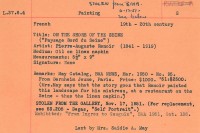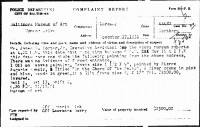 The good news is that the paper trail confirms that Paysage Bords de Seine, the small landscape painting by Pierre Auguste Renoir reportedly purchased along with a plastic cow and Paul Bunyan doll for $7 at the Harpers Ferry Flea Market in West Virginia, is indeed authentic. The bad news is it was stolen from the Baltimore Museum of Art 61 years ago and therefore does not legally belong to the lady who found it. This morning’s planned auction has been cancelled, and the FBI is now on the case.
The good news is that the paper trail confirms that Paysage Bords de Seine, the small landscape painting by Pierre Auguste Renoir reportedly purchased along with a plastic cow and Paul Bunyan doll for $7 at the Harpers Ferry Flea Market in West Virginia, is indeed authentic. The bad news is it was stolen from the Baltimore Museum of Art 61 years ago and therefore does not legally belong to the lady who found it. This morning’s planned auction has been cancelled, and the FBI is now on the case.
The news came as a surprise to the Baltimore Museum of Art. Washington Post reporter Ian Shapira was trying to trace the movements of the painting after it was purchased from the Bernheim-Jeune gallery in Paris by collector Herbert L. May in 1926. May’s ex-wife Saidie Adler May was a major donor to the Baltimore Museum of Art, and many of her papers are kept at the museum’s library. While looking through a box of Saidie’s correspondence and receipts, Shapira found a note recording that she had loaned Paysage Bords de Seine to the museum in 1937.
 The BMA had already checked its ownership records of the vast Saidie May Adler collection when the auction house did its due diligence. There was no mention of the Renoir piece being among the more than one thousand paintings donated to the museum by Mrs. Adler. Nobody even thought to check the loan records until Shapira found the note, which included a loan registration number. Museum director Doreen Bolger looked it up and discovered an orange index card describing the painting, the story behind its creation, its purchase for $1,000 at Bernheim-Jeune and then, in November of 1951, its theft from the Baltimore Museum of Art’s display gallery.
The BMA had already checked its ownership records of the vast Saidie May Adler collection when the auction house did its due diligence. There was no mention of the Renoir piece being among the more than one thousand paintings donated to the museum by Mrs. Adler. Nobody even thought to check the loan records until Shapira found the note, which included a loan registration number. Museum director Doreen Bolger looked it up and discovered an orange index card describing the painting, the story behind its creation, its purchase for $1,000 at Bernheim-Jeune and then, in November of 1951, its theft from the Baltimore Museum of Art’s display gallery.
A shocked Bolger called Elizabeth Wainstein, president of the Potomack Company, the auction house where the painting was to be sold, who immediately agreed to stop the sale. Together they called the FBI to report the theft. Further research revealed a City of Baltimore police report (pdf) from November 17th, 1951 in which James M. Porter Jr., Executive Assistant at the museum, declares that “some time between 6 P.M. Nov 16 & 1 P.M.” November 17, “some one” stole the Renoir in its gilt frame from the museum with “no evidence of forced entrance.” That seems to have been the end of it. No follow-up has been found in the police archives as of yet, and the story never made the papers.
 Both the loan record and the police report note that the painting was insured for $2,500. It’s not clear to me whether there are confirmed records of the insurance company paying out at that time, but that seems to be the assumption. The BMA isn’t sure who the insurers were, but if the company can be pinpointed and still exists today, it could well be the legal owner of the Renoir. It depends on the details of the insurance agreement and on Maryland law in 1951.
Both the loan record and the police report note that the painting was insured for $2,500. It’s not clear to me whether there are confirmed records of the insurance company paying out at that time, but that seems to be the assumption. The BMA isn’t sure who the insurers were, but if the company can be pinpointed and still exists today, it could well be the legal owner of the Renoir. It depends on the details of the insurance agreement and on Maryland law in 1951.
Paysage Bords de Seine will stay at the auction house until the FBI investigation determines who is the rightful owner of the piece. It’s a tricky question. Saidie Adler May died in May of 1951. She left her entire collection to the Baltimore Museum of Art in her will, and her estate was still being probated when the painting was stolen six months later. The BMA thinks they’re the rightful owners since that’s what Saidie Adler May clearly intended, but if they took the money from the insurers, May’s intent may be irrelevant.
Elizabeth Wainstein questions whether Saidie was even the technical owner of the painting, since according to the Bernheim-Jeune gallery’s records it was sold to Herbert L. May, not his wife. This seems shaky to me. The Mays had been separated for two years in 1926 when Herbert bought the painting. They got divorced in 1927. Paysage was in Saidie’s hands ten years later when she loaned it to the Baltimore Museum of Art, so unless we’re to assume she stole it from her estranged husband, she probably got it in the divorce.
I’m afraid “Renoir girl,” the lady who purportedly made the score of the century while flea marketing, is probably the last on the list of potential legitimate owners. She may be entirely innocent of any wrong-doing, but finders keepers doesn’t apply with stolen goods. Whoever legally owned it last — May estate, museum or insurer — probably owns it now.
Legal wrangling aside, the orange index card tells a lovely story of how the painting came to be. In addition to being charming, it also explains something that bugged me about the painting; namely, the large unpainted margins left and right, particularly noticeable on such a small piece (5.5″ x 9″). It was not painted on a stretched canvas, you see, but rather on a linen napkin. From the loan record:
Mrs. May says that the story goes that Renoir painted this landscape for his mistress, at a restaurant on the Seine – thus the linen napkin.
That would certainly explain why it looks so unfinished and dashed off compared to Renoir’s larger, more complex Seine landscapes like Landscape of Wargemont.
My money would be on the insurers.
I think it’s silly that the president of the auction house, Ms. Wainstein, would think of contesting such obvious ownership. It was sold to Mr. May whilst they were still married – i.e., separation isn’t divorce. More doubt arises with Ms. Wainstein’s lack of proper research. The fact that she stopped her research at the point only when it was sold to Mr. May says to me that she was more anxious to sell the painting and create a sensational story. It took the Washington Post writer little time to do research on the painting and to find that it had been stolen from the BMA – to where Mrs. May has a wing in her name because of her many donations to the museum. There was more to the story but Ms. Wainstein neglected to find out what it was.
In my opinion the Renoir should be handed over to the FBI until the investigation is completed and not at the Potomack Company where it currently resides. I doubt that it currently belongs to her – or anyone at this point. I say “turn over the painting, Ms. Wainstein!”
Amazing story! Worthy of History Detectives on PBS! http://www.pbs.org/opb/historydetectives/
I hope the museum gets the painting back; they could refund any money they got from the insurance co., and that should be sufficient, I should think.
Too bad for the finder, but at least she did get a plastic cow and a Paul Bunyan for her $7.00!
The problem is if the insurance company or its corporate descendants are still around, they would have to be pretty idealistic to be willing to accept repayment over ownership of a painting worth far more than the $2500 they spent. The museum might have to offer something more, like market value.
Hopefully the Paul Bunyan doll and plastic cow are still legit.
I think we can rest assured that she has clean title on both of those.
An excellent new twist to the story. I questioned the legitimacy of the painting as an authentic Renior due to it’s slap dash execution but now we know why it was so hastily and atypically constructed.
I’m now dying to know its story between winter of 1951 and its rediscovery in a West Virgina rummage sale. Part of me really hopes it brightened a cabin in some holler in the mountains. Everybody who came by was like “Your kid paint that? That’s real good.”
😆 I’m picturing the whole frame tied to a fridge in lieu of magnets.
If it turns out the stolen painting was a fake back in 1951, or if it been originally created by a now out-of-favor artist and depreciated since the insurance payment, I doubt anyone would be suggesting that the museum return the insurance payment and forced to accept the return of the item.
Well, no because fakes aren’t ideally part of museum permanent collections. Authentic works are. In any case the insurance company doubtless had their own authentication process before they agreed to coverage, so it’s not like they would have been duped under false pretenses or anything.
There’s no reason why the museum couldn’t appeal to the insurance company to work something out. Corporations regularly sponsor museum exhibits and large purchases, so it’s not outlandish to suggest a deal of some sort could be struck.
Actually, Yes. I’m making a different point. Poorly, appearantly. I just think it is funny how many people rush to assume the insurance company should accommodate but how few would expect the insured to accommodate if the situation (and financial implications) were flopped. I never hear of someone saying, “Hey, insurance company, thanks for finding my Honda Accord stolen from me three years ago. Since it is worth less now than when you paid for my loss, how about if I return some of this cash you gave me back then and I take back my now-less-valuable vehicle?”
I don’t think the analogy works because there’s a marked difference between cultural patrimony and consumer goods. Three-year-old Honda Accords don’t belong in museums. Renoirs, on the other hand, do, and that’s where this one was before it was stolen. It’s not any kind of irony that people want to see stolen artwork returned to the museum whereas they don’t care at all about the ultimate disposition of a stolen Honda. Just because they’re both stolen and both insured doesn’t make them interchangeable.
The story is fascinating. It is intriguing to me that the parties agreed to let is remain at auction house since the auction client would appear to be the one person all would agree has no valid ownership interest. I think it should go the the museum pending resolution. They are capable of securing it (past history notwithstanding) and the publicity of the dispute might boost interest (and value for the ultimate owner).
I suspect it’s a matter of convenience. It’s just a lot easier for the FBI to keep it where it is right now than to have to adjudicate between the interested parties or take on the responsibility of securing it themselves.